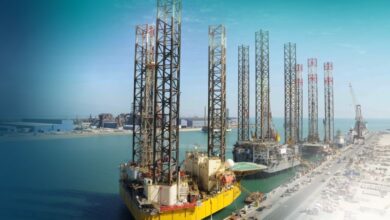‘Major changes’ coming for API Spec 2C
“There’s going to be some fairly major changes” in the 7th edition of API Crane Specification 2C, Doug Morrow, Seatrax, said at the IADC Lifting & Mechanical Handling Conference on 14 July in Houston. For one, the API Spec 2C Committee decided to “bite the bullet” during this revision and address the gross overload/supply boat entanglement issue, Mr Morrow said. For another, the scope of the specifications has been broadened to include new kinds of cranes not included before, a change from 2C’s previous focus on oil production and drilling facilities.
Now, all types of offshore cranes have been incorporated, including construction, derrick barges, pipe lay vessels, shipboard cranes and knuckle boom cranes. Duty cycle consideration, wire rope design factors and structural design factors all needed updates as well. “All of this has caused us to have to make some pretty drastic changes in the entire document,” Mr Morrow said.
He explained that the 7th edition of 2C will address gross overload using failure mode assessments. These assessments will be required to protect the crane operator in the event of an unbounded gross overload (supply boat entanglement).
If the failure mode can’t be met, a gross overload protection system (GOPS) will be required to ensure that the structure holding the operator doesn’t fail in the event of a gross overload.
In comparison, the European standard EN 13852 (API 2C’s competitor specification) requires an automatic overload protection system (AOPS), which senses an overload and releases the load. With AOPS, equipment damage is considered unacceptable.
“It’s, in our view, a massive overkill and a horrible solution to a problem that we don’t have very often. This is why we have taken the steps we have to address the (gross overload) issue,” Mr Morrow said. For his group, equipment damage is considered an acceptable outcome, he said.
With the change in scope of 2C, Mr Morrow explained that the API specs already face competition from EN 13582-1 and -2; moreover, there has been a push for the ISO to adopt international standards for cranes. That’s why API decided to “spiff up” 2C and create a truly viable international product, Mr Morrow said.
On structural fatigue, the new edition of 2C has a requirement of 1 million cycles at 50% onboard SWL (safe working load). The previous edition’s requirement was 25,000 cycles at 133% of maximum SWL. The new edition also differentiates between structures and machinery, whereas EN 13852 and ISO assume that machinery and structures have the same useful life, he said.
The 6th edition did not address duty cycle, only structural fatigue. The revised specs recognize that machinery is expected to last five years before major overhaul/replacement. A piece of machinery will be replaced or overhauled multiple times before the crane structure is retired. 2C has created duty classifications based on historical crane usage data: production duty, construction duty, intermediate duty and drilling duty.
Changes also were made to wire rope design factors. The sliding factor is based on the SWL, allowing larger cranes lower factors in line with industry practice, Mr Morrow explained.
Since the 7th edition is more of a purchase spec and will not be retroactive, there will be little to no effect on cranes covered by the 6th edition, Mr Morrow clarified.





We have completed a Drilling Engineering Association, Project 160, Our process virtually verifies the shoulder, thread, seal, torque, & ovality within the connection in real time with no rig down time. We have found a great number of connections (8 round & premium) do not make up to the manufactures specifications due to QC and handling. Our process should be verified by API to combat twist offs, washouts, back offs, parting, poor seal engagement & evironmental problems. Please contact Ray Dishaw 972-924-5000 for more information.